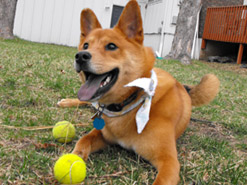Dog Consultations
I offer private, in-home, sessions that last 2 to 3 hours plus one short follow-up. Just one consultation with me can help eliminate unwanted behaviors.
Call (913) 735-3364 to speak directly with me.
Or, shoot me an email.
I need help with my dog!
Great! I am here to help. Just send me an email or give me a call at
(913) 735-3364, and we can schedule a consultation.
What is a 1-on-1 dog training session?
An 1-on-1 dog training session allows me to evaluate you and your dog and assess the actual behavioral issues at hand. During the session I will work directly with you, your dog, and any family. We will discuss dog psychology, deal with any issues head on, and my goal is to empower you to deal with any issues that come up even if I'm not around.
Do you do in-home consultations? Or, do I come to you.
Yes. Currently I ONLY offer in your home consultations.
Do you travel oustide of Kansas or Missouri?
On a case-by-case basis, yes. You will have to pay for my travel expenses, which we can work out.
What about group classes? Shouldn't I just do that instead?
One of the reasons I decided to become a dog rehabilitator was because I went to the group classes with my dog and all I learned was how to feed my dog's excitement with treats. In addition, going to a group class is kind of like going to marriage counseling with 30 other couples. Personally, I feel personal instruction is the only real way for you to learn how to communicate with your dog and deal with their unique behavioral issues.
What kind of dogs do you work with?
I work with any kind of dog. Breed has little to do with my rehabilitation techniques. I communicate on a very primal level that all dogs of any breed understand.
What kind of dog behavioral issues can you solve?
I can help with the following dog behavioral problems:
- Aggression / Biting
- Fear & Anxiety
- Pulling on Leash
- Chewing and Destruction
- Unsocialized Behavior
- Jumping Up
- Basic Obedience
- Annoying Barking
- Mounting
- Marking
- And more...
How are you different than obedience training?
Obedience training generally uses positive reinforcement (treats and affection) to shape your dog's body position. It does not pay close attention to your dog's mind and can often lead to teaching your dog how to avoid situations, but never how to deal with them calmly.
For instance, in classic obedience training, we often teach a dog how to "sit". This includes getting the dog's butt to touch the floor and then rewarding with lots of yummy treats and affection. However, the dog's mind is usually waiting for the treat. As soon as she gets it, her attention is back where it was before.
But, did you know that all dog's know how to sit from birth? In a pack of dogs, a more dominant dog can get another unstable dog to "sit" (put their butt to the floor) simply by applying psychological or physical pressure. This is a primal ritual for dogs and means a lot more than give me that treat. Rather, the "sitting" dog is showing acceptance of the more dominant dog's leadership. In essence, they are saying, "I am ready to follow your lead."
What kind of tools do you use to train dogs?
I can use a variety of dog training tools in an effective and humane way.
Are Prong Collars, Choke Chains, etc, cruel?
Yes, if used inappropriately. As is a normal leash. Any tool can be used in cruel ways, but understanding the tool's purpose can allow us to use it in a very natural manner that dog's understand.
For instance, a prong collar can simulate a natural correction of another dog biting down on the neck of an unstable dog, if used properly. If used improperly it can severly hurt a dog, but so can the bite of the correcting dog.
Can't you just train a dog without tools?
Tools are simply an extension of your body and a means of empowerment. If I was a dog I wouldn't need to use a tool other than my energy & body language. However, I'm not a dog, so I work with tools that empower me and mimic natural dog corrections.
My primary tool is the Halti, which is a very gentle & humane head collar that mimics a natural dog correction observed in a pack of dogs. This involves another dominant dog going over to an unstable dog and gently applying pressure (not pain) to the muzzle. As soon as the unstable dog complies, the pressure releases. Even moms display this behavior to communicate with their young pups. I will show you how to work with the Halti to effectively communicate with your dog.
Are you going to hurt my dog?
No, I love dogs! I will show you how to communicate with your dog in order to stop any behavior issues. It is very important to match the intensity of a dog's instability in order to correct appropriately. But never does this include hitting or kicking a dog, or correcting a dog while angry or frustrated.
Will you do all the work?
No, I will guide you so that when I leave, you will have the means to communicate with your dog and handle any situation that arises.


